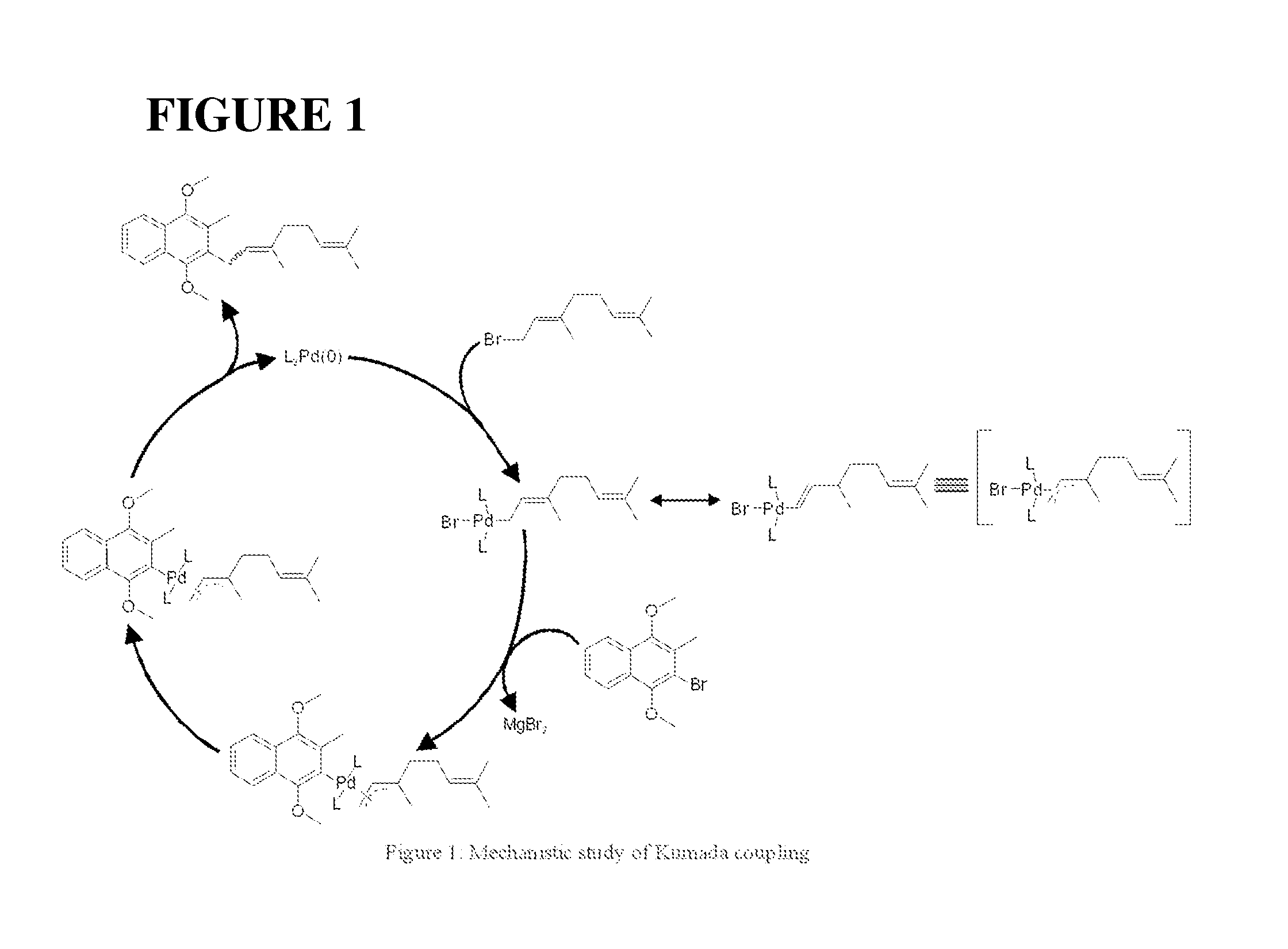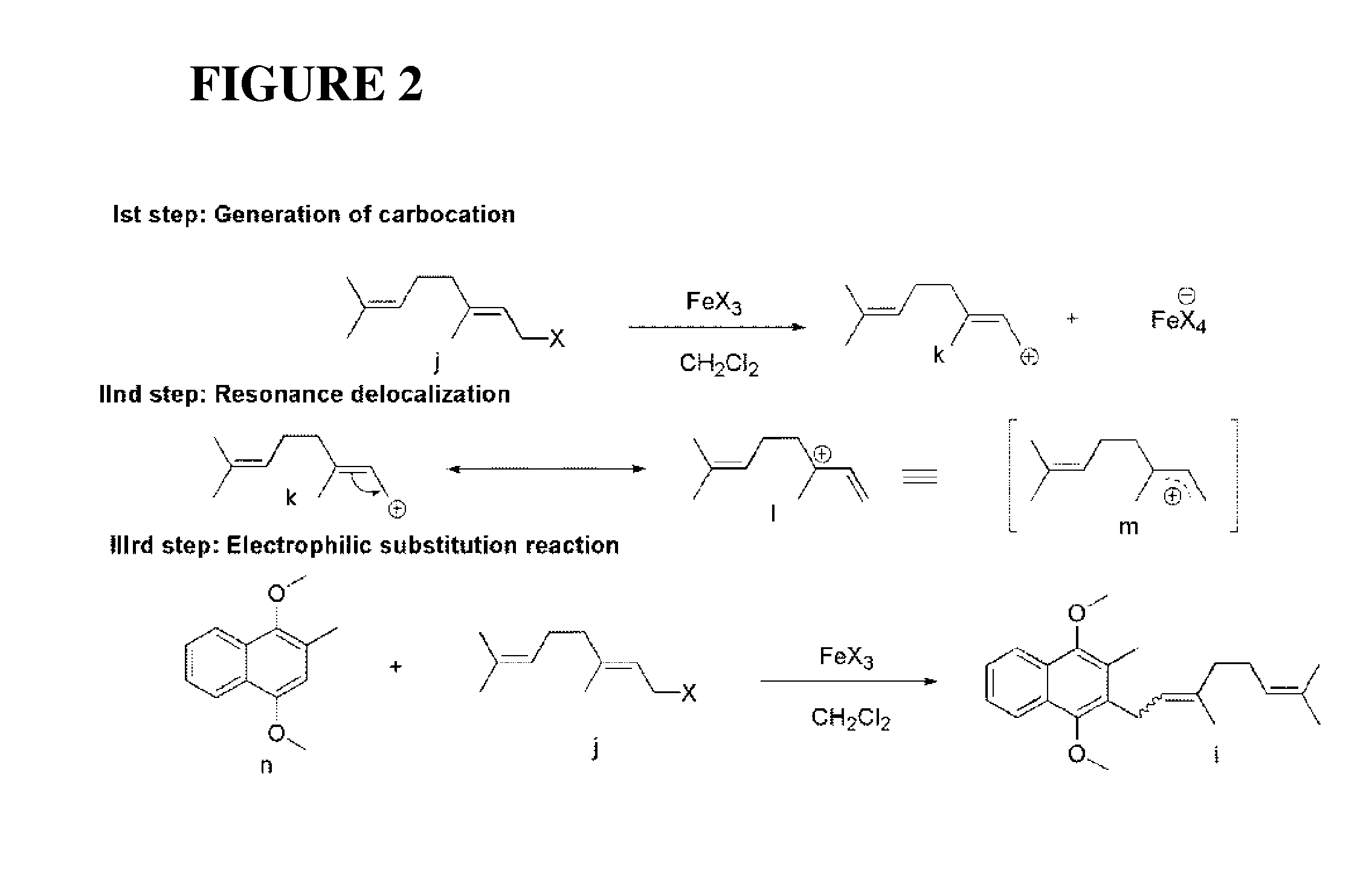Method of preparation of stereospecific quinone derivatives
- Summary
- Abstract
- Description
- Claims
- Application Information
AI Technical Summary
Benefits of technology
Problems solved by technology
Method used
Image
Examples
examples 1 to 5
Synthesis of β,γ-Unsaturated Ester
[0145]Synthesis of the stereospecific β,γ-unsaturated ester, a novel compound claimed in this patent, is the starting point of the present scheme as the geometrical purity of this molecule controls the stereo-purity of the α-double bond of vitamin K1, K2 series and ubiquinone series. Further, this starting point reduces the problem to the stereoselective attachment of prenyl side chains.
[0146]The preparation of the β,γ-unsaturated ester was carried out according to the following reaction scheme, consisting of four steps, employing commercially available menadione as the starting material.
example 1
Preparation of 2-Methyl-naphthalene-1,4-diol
[0147]
[0148]To a 400 ml solution of menadione (50 g, 0.29 mol) in EtOAc, was added a solution of sodium dithionite (120 g, 0.69 mol) in 100 ml water under nitrogen atmosphere. The reaction mixture was subjected to vigorous stirring. The discoloration of the organic layer indicated the completion of the reaction which was supported by TLC observation. Then 100 ml of 1M Sodium metabisulfite solution was added. The aqueous layer was separated and extracted with Ethyl acetate (2×50 ml). The combined organic layers were washed with saturated sodium chloride solution and finally dried over MgSO4 before evaporating the solvent in vacuum. A pale purple solid was recovered which was titurated with 300 ml of hexanes and the solid was filtered off to obtain 2-Methyl-naphthalene-1,4-diol (50 g, 98% yield) which was used for the next reaction without any purification.
example 2
Synthesis of 1,4-Dimethoxy-2-methyl-naphthalene
[0149]
[0150]To a 50 ml solution of 2-Methyl-naphthalene-1,4-diol (3.8 g, 0.022 mol) in acetone was sequentially added K2CO3 (15.20 g, 0.11 mol) and dimethylsulfate (10.43 ml, 0.110 mol). The resulting orange colored reaction mixture was refluxed for 6 h at which time TLC indicated the completion of the reaction. The reaction mixture was the filtered and the filtrate was treated with 1N NaOH solution to adjust the pH to 5 or 6. The organic layer was separated and washed with brine before drying over Na2SO4. Solvent was removed under reduced pressure to provide a thick oil (3.7 g, 85%) which eventually solidified at lower temperature. 1H NMR (400 MHz, CDCl3): 8.17-8.19 (d, 1H, J=8.24 Hz), 8.00-8.02 (d, 1H, J=8.24 Hz), 7.50-7.41 (t, 1H, J=8.24 Hz), 6.59 (s, 1H), 3.85 (s, 3H), 2.44 (s, 3H), 1.42 (s, 3H).
PUM
 Login to View More
Login to View More Abstract
Description
Claims
Application Information
 Login to View More
Login to View More - R&D
- Intellectual Property
- Life Sciences
- Materials
- Tech Scout
- Unparalleled Data Quality
- Higher Quality Content
- 60% Fewer Hallucinations
Browse by: Latest US Patents, China's latest patents, Technical Efficacy Thesaurus, Application Domain, Technology Topic, Popular Technical Reports.
© 2025 PatSnap. All rights reserved.Legal|Privacy policy|Modern Slavery Act Transparency Statement|Sitemap|About US| Contact US: help@patsnap.com



